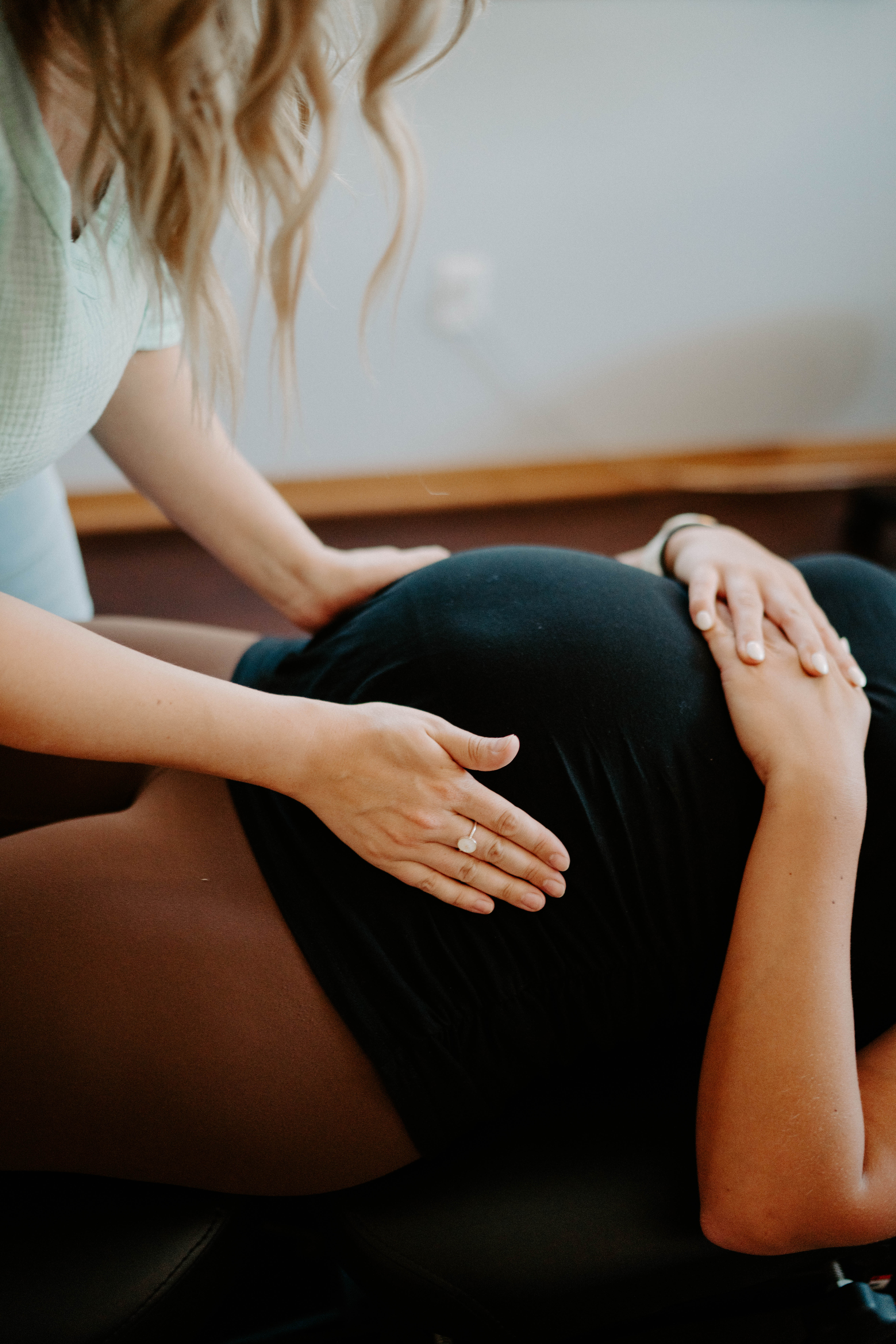WElcome TO
Explore our blog that focuses on holistic care for any and all ages - pediatric well-being, pre/post-natal health, and adult vitality.
THE BLOG

You walk into another doctor’s appointment. You share your concerns about your child’s health challenges—the digestive issues, the sleep problems, the behavioral struggles. The doctor glances at the chart, spends maybe five minutes with you, and hands you a prescription or tells you to “wait and see.”
You leave feeling dismissed. Unheard. Like you’re just collecting labels and medications without ever getting real answers about what’s actually wrong.
If this sounds familiar, we want you to know something important: as a parent, you don’t have to settle for this anymore. You have the power to choose a healthcare provider who actually listens, who digs deeper than the symptoms, and who cares for your child as a whole person—not just a diagnosis code.
As we step into this new year, it might be time to ask yourself: Is your child’s doctor really serving your family? Or is it time for a change?
You’re Not Alone in This Journey
This isn’t just about you. Every single week, we see parents who are exhausted from the medical run-around. You’re tired of collecting diagnoses without solutions. You’re ready for a doctor who partners with you to find real answers.
Many parents come to us after years of appointments, specialists, therapies, and medications. They’ve been told their child has ADHD, anxiety, Sensory Processing Disorder, chronic ear infections, digestive issues—sometimes all of the above.
But here’s what almost never happens in traditional healthcare: no one asks why. No one connects the dots between all these challenges. No one looks at the pregnancy complications, the difficult birth, the early stress patterns, the rounds of antibiotics, and realizes these aren’t separate problems. They’re pieces of the same puzzle.
When multiple factors pile up—what we call “The Perfect Storm“—they create a foundation of nervous system stress that shows up in different ways across different children. One child develops gut issues. Another struggles with focus and behavior. Another can’t sleep through the night.
Traditional healthcare treats each symptom separately. But what if there’s one thread connecting all of it?
Three Essential Traits to Look for in Your Child’s Healthcare Provider
When choosing a doctor who can truly help your child thrive, there are three essential qualities that separate providers who mask symptoms from those who restore health.
1. A Doctor Who Listens and Seeks Root Causes
Gone are the days when you had to accept the “dictator-style” doctor who tells you what to do without really hearing your story.
The best doctors ask questions about your pregnancy, your labor and delivery, birth interventions like forceps or C-section, and early childhood experiences like colic, reflux, and infections. They piece together your child’s health timeline, rather than treating each issue in isolation.
They understand the “Perfect Storm”—that combination of prenatal stress, birth trauma, environmental toxins, antibiotic overuse, and ongoing stressors that disrupts health and development over time.
Most importantly, they empower you as a partner in your child’s care, not as someone who just follows orders.
When a doctor truly listens, they can identify patterns you might have missed. They help you see how everything connects. And that’s when real healing can begin.
2. Expertise in Neurology and the Nervous System
Here’s what most parents don’t know: the nervous system is the Air Traffic Controller of your child’s entire body. It coordinates every function—digestion, immunity, sleep, behavior, development, everything.
When the nervous system gets stuck in stress mode, it’s like trying to run your child’s body with the parking brake on. Nothing works the way it should.
A neurologically-focused doctor understands subluxation—that’s when the nervous system experiences interference that disrupts the brain-body connection, leading to dysregulation and health challenges.
They use advanced technology, such as INSiGHT scans, to actually measure nervous system function instead of just guessing. They know that development matters. Not just hitting milestones on time, but the sequence and quality of those milestones, because they reflect what’s happening in the nervous system.
This neurological perspective changes everything. Instead of asking “what’s wrong with my child,” you can start asking “what’s interfering with my child’s natural ability to heal and develop?”
3. A Collaborative, Team-Based Approach
Complex health challenges need more than one perspective. The best doctors don’t operate in silos—they work as part of a team.
They value input from physical therapists, occupational therapists, speech pathologists, nutritionists, and other specialists who each bring unique insights. They serve as the quarterback, coordinating care to ensure everyone’s working toward the same goals and that your child’s progress is tracked and adjusted as needed.
They understand that restoring nervous system balance often unlocks progress in other therapies. When the foundation is solid, everything else falls into place.
When healthcare providers work together instead of separately, your child gets comprehensive care that addresses the whole picture, not just isolated symptoms.
You Have the Power to Choose Differently
As you step into this new year, you have the power to choose differently for your child. You deserve a doctor who listens, who understands how the nervous system controls health, and who collaborates with your entire care team.
Your child deserves more than “wait and see.” They deserve answers.
When you’re evaluating potential healthcare providers, ask yourself:
- Does this doctor take time to understand my child’s complete health history?
- Do they look for connections between seemingly unrelated symptoms?
- Do they focus on the nervous system as the foundation of health?
- Do they work collaboratively with other providers?
- Do they empower me as a partner in my child’s care?
Your instincts as a parent are powerful. If you’ve been feeling dismissed, unheard, or stuck in a cycle of managing symptoms without addressing causes, trust that feeling. It’s telling you something important.
This new year can be different, and RCW would love to help. We see your child as a whole person and would love to partner with you to find real answers and help your family thrive. You’re not asking for too much; you’re asking what every child deserves. So don’t wait to contact us today to schedule a consultation.
Remember: You’re not just choosing a new doctor. You’re choosing hope, partnership, and a path forward that honors your child’s potential to heal and thrive.

You’re exhausted. You’re worried. And now someone’s telling you to “just relax” for your baby’s sake—as if you haven’t tried that already.
Between the nausea, the fear, the financial pressure, and everyone’s unsolicited advice, you’re barely holding it together. And honestly? The guilt associated with being stressed may feel worse than the stress itself.
You know something about this chronic stress isn’t right, but no one’s explaining what’s really happening inside your body—or inside your baby’s developing brain.
Here’s what most doctors won’t tell you: that umbilical cord isn’t just delivering nutrients and oxygen. It’s creating a connection between your nervous system and your baby’s developing nervous system. When you’re stuck in stress mode, your baby’s nervous system learns that this stressed state is “normal” during the most critical window of brain development.
This isn’t about blaming you. This is about understanding fetal programming—how what you’re experiencing right now is creating lasting patterns in your baby’s nervous system that can affect their health trajectory for years. And more importantly, what you can actually do about it.
Your Nervous System Is Teaching Your Baby’s Nervous System
The umbilical cord is so much more than a nutrient delivery system. It’s the electrical connection between your nervous system and your baby’s. When stress hormones like cortisol stay elevated in your body, they cross the placenta and flood your baby’s developing brain.
Your baby’s nervous system is being programmed right now. If you’re stuck in sympathetic dominance—that constant “fight-or-flight” mode—your baby’s nervous system learns this as baseline normal.
Think of the nervous system as the air traffic controller for every other system in the body. If the air traffic controller is stuck in panic mode, everything else malfunctions.
Research published in Development and Psychopathology found that infants of mothers with the highest stress levels showed 22% higher stress reactivity. These babies were more easily upset, harder to soothe, and showed poorer recovery from stress. That pattern was established during pregnancy, before they ever took their first breath.
Fetal Programming Creates Lifelong Patterns
Fetal programming means permanent changes. During pregnancy, your baby’s amygdala (the fear center of the brain) develops larger and more reactive when exposed to chronic stress. The HPA axis—your baby’s stress response system—gets programmed with a hair-trigger baseline.
Think of it like building a house on a cracked foundation. You can’t remodel a house on a cracked foundation and expect it to be stable. Your baby’s nervous system foundation is being built right now, and chronic stress creates cracks in that foundation before they’re even born.
The vagus nerve, the main nerve of the parasympathetic system, develops its tone during pregnancy. Poor vagal tone from prenatal stress can affect digestion, heart rate, inflammation, immune function, social engagement, and emotional regulation for years to come.
Children whose mothers experienced chronic stress during pregnancy have higher rates of ADHD, anxiety, Sensory Processing Disorder, and even physical health issues like asthma and allergies. This isn’t bad luck or a coincidence. It’s fetal programming.
Understanding the “Perfect Storm”
For many families, the “Perfect Storm” begins before pregnancy even starts. Fertility struggles. Multiple rounds of IVF. Months or years of emotional weight, hormonal medications, financial strain, and relationship stress. By the time pregnancy finally happens, the nervous system is already depleted.
Then pregnancy adds its own layer of stressors: physical discomfort, fear about the baby’s health, anxiety about labor, financial pressure, work stress, and relationship challenges. Your baby is developing in this environment.
Here’s the hard truth: they don’t grow out of it. They grow into other challenges.
Colic at two months becomes chronic constipation at six months. Constipation becomes sensory sensitivity at 18 months. Sensory issues become ADHD signs at age five. ADHD becomes anxiety by age ten. The nervous system dysfunction that began during fetal programming manifests differently as the brain develops through various stages.
You Can Help Your Nervous System Regulate—Starting Now
Here’s what you need to hear: You can’t eliminate every stressor. That’s impossible, and it’s not your responsibility to somehow create a stress-free existence while growing a human being.
However, you can help your nervous system shift from sympathetic dominance to parasympathetic function, creating a calm, regulated internal environment that supports healthy fetal development.
How Neurologically-Focused Chiropractic Care Can Help
Neurologically-Focused Chiropractic Care works at the foundational level. Gentle, specific adjustments help release the “parking brake” on your nervous system, allowing it to shift out of survival mode and into a state of regulation.
Advanced technology like INSiGHT scans provides objective data about your nervous system function:
- Heart Rate Variability (HRV) measures the balance between your sympathetic and parasympathetic systems
- Surface Electromyography (sEMG) shows where your nervous system is holding tension
- NeuroThermal scans detect areas of dysregulation
These scans track improvements in your nervous system function—often before you even notice symptom changes.
When you’re regulated, your baby learns regulation. This is your window of opportunity. Pregnancy is when the foundation gets built. What you do now affects not only your pregnancy experience but also your child’s lifelong health trajectory.
A Real Story: Catherine’s Fifth Pregnancy
Let me tell you about Catherine. This was her fifth pregnancy, but only her second under Neurologically-Focused Chiropractic Care.
Her previous pregnancies without care were filled with unrelenting heartburn, sciatic pain, crushing fatigue, and overwhelming stress.
This time? She got adjusted 2-3 times a week throughout her pregnancy. Even though this was the oldest she’d ever been during pregnancy, she felt the best out of any of them. Her nervous system stayed regulated. Her symptoms were minimal. She had the energy to keep up with her other kids. She slept great. Her heartburn was manageable.
The neurological scans lined up exactly with what she was feeling. Her adjustments were tailored to what her body was showing. And just weeks away from baby number five, Catherine said this was the most confident she’d ever felt heading into labor and delivery. She knew her body was ready because she’d kept her nervous system regulated throughout the entire pregnancy.
You Have More Control Than You Think
At Rochester Chiropractic and Wellness, we understand that your baby’s nervous system is developing right now. Your nervous system teaches your baby’s nervous system. The intervention you pursue now—addressing nervous system dysregulation at the root cause level—affects your child’s health trajectory for years to come – and we want to help!
You have more control than you think. Not by somehow eliminating all stress from your life (impossible), but by helping your body regulate despite it. So do not hesitate to reach out to us today to schedule a consultation.
You deserve to feel supported. So if you are not local to us, check out the PX Docs directory to find an office near you. Your baby deserves a calm, regulated foundation. And it’s not too late to start creating that environment right now.

As a parent, you want nothing more than to see your child thrive. You’ve probably spent countless nights worrying when they struggle with sleep, meltdowns, focus issues, or mysterious health problems that seem to have no clear cause. You’ve likely tried everything your pediatrician suggested, maybe even worked with specialists, yet somehow you still feel like you’re missing a crucial piece of the puzzle.
What if we told you that the key to unlocking your child’s full potential might be hiding in plain sight within their own body? The secret lies in something called nervous system regulation—and understanding it could transform your approach to your child’s health and well-being.
Jake’s Story: From Explosive Meltdowns to National Champion
Let usshare Jake’s story with you. When Jake turned 2.5, his parents watched their sweet, smiling little boy transform. Suddenly, he began experiencing intense tantrums, crying spells, and explosive angry reactions that seemed to come from nowhere. When triggered, his anger would escalate quickly—yelling, stomping, calling himself “stupid,” and sometimes even hitting himself.
His parents felt helpless. With every outburst, they grew more desperate. They had conversations with pediatricians, attended weekly therapy sessions, sat through countless school meetings with teachers and social workers, navigated 504 plan discussions—all while longing for peace for Jake and hoping to bring calmness back to their family.
After an especially explosive event at a martial arts competition, Jake’s family knew they needed a completely different approach. They had heard about neurologically-focused chiropractic care from a friend and decided to take a chance.
The transformation didn’t happen overnight, but with consistency and time to help rewire and regulate Jake’s nervous system, they began to see remarkable changes. After about 3-4 months, Jake’s mom noticed he appeared calmer. He began using his words to express his feelings instead of reacting explosively. He was less anxious, less combative, and less intense overall.
But here’s the most incredible part: Jake went on to compete in the AAU National Karate Tournament, where he took home two gold medals—becoming a National Champion in two events! The same child who once struggled with explosive anger had learned to channel his energy and emotions in a completely different way.
Understanding Your Child’s Nervous System: The Foundation of Health
So what exactly happened with Jake? To understand this transformation, you need to know about nervous system regulation—something that affects every aspect of your child’s health but is often overlooked in traditional healthcare approaches.
What Is Nervous System Regulation?
Think of your child’s nervous system as the master control center for their entire body. It helps keep everything balanced and stable, ensuring that every bodily system can communicate effectively and work in harmony. This state of balance is called homeostasis.
When your child’s nervous system is properly regulated, everything functions optimally:
- Basic functions like sleeping, eating, and digestion work smoothly
- Advanced functions like controlling inflammation and managing immune responses operate effectively
- Mental, emotional, and cognitive health remain stable and resilient
When Things Go Wrong: The Signs of Dysregulation
When your child’s nervous system becomes overly stressed and imbalanced, it enters a state called nervous system dysregulation. This can manifest in many different ways, often starting with disruptions to basic health functions.
Early warning signs you might notice:
- Difficulty falling asleep or staying asleep
- Digestive issues or irregular eating patterns
- Mood swings or emotional instability
- Low energy or hyperactivity
- Trouble with emotional regulation
If you’re seeing these challenges in your child, they’re not character flaws or behavioral problems—they’re signs that your child’s nervous system needs support.
The Autonomic Nervous System: Your Child’s Internal Thermostat
The key to understanding nervous system regulation lies in something called the autonomic nervous system. This system controls and coordinates all the major functions of your child’s body, managing trillions of cells almost entirely on “autopilot.”
The autonomic nervous system has two main branches:
The Sympathetic System (“Fight or Flight”): This kicks in during times of stress, danger, or high activity. It’s designed to help your child respond to challenges, but it’s not meant to be constantly activated.
The Parasympathetic System (“Rest, Relax, and Regulate”): This is where the magic happens. When this system is active, your child’s body can rest, repair, restore, and regulate itself.
The Vagus Nerve: This crucial nerve is primarily responsible for activating the “rest and regulate” response. If your child has any damage or dysfunction in their vagus nerve, their nervous system will struggle to find balance and regulation.
The Perfect Storm: How Dysregulation Develops
Nervous system dysregulation doesn’t happen overnight—it often develops through what experts call “The Perfect Storm” of stressors and challenges.
In infancy, this might look like:
- Difficulty nursing and eating
- Trouble soothing and sleeping
- Being colicky and fussy
- Acid reflux or constipation
- Skin issues like eczema
As children grow, you might see:
- Chronic ear infections
- Respiratory and immune system struggles
- Difficulties with motor planning and developmental milestones
- Challenges reaching age-appropriate developmental markers
Eventually, a dysregulated nervous system can manifest as:
- Big emotions and frequent meltdowns
- Attention and focus challenges
- Sensory processing difficulties
- Behaviors that look like ADHD or autism spectrum characteristics
Factors That Can Contribute to Dysregulation
Understanding what can contribute to nervous system dysregulation empowers you to be more aware and proactive about your child’s health:
- Birth-related stress: Difficult pregnancies, birth interventions, or traumatic birth experiences
- Environmental toxins: Exposure to chemicals, pollutants, or other harmful substances
- Physical trauma: Falls, accidents, or even repetitive strain from things like heavy backpacks
- Emotional stress: Family changes, school pressure, or social challenges
- Poor nutrition: Diets high in processed foods or lacking essential nutrients
- Lack of movement: Sedentary lifestyles that don’t support healthy nervous system development
Taking Action: What You Can Do as a Parent
The good news is that nervous system dysregulation isn’t permanent. Your child’s nervous system has an incredible capacity for healing and adaptation when given the right support.
This is where neurologically-focused chiropractic care comes in, and this is what Rochester Chiropractic and Wellness does best. Like what helped Jake, we use advanced scanning technology, INSiGHT Scans, to identify areas of nervous system stress and then gentle adjusting techniques to help restore balance.
This approach doesn’t rely on medications or invasive procedures. Instead, it works with your child’s natural healing capacity to help their nervous system return to a state of regulation and optimal function.
Your Child’s Potential Is Waiting
Imagine a world where your child can face life’s challenges with resilience, focus with ease, and truly thrive. That’s the power of a well-regulated nervous system. Your child doesn’t have to struggle with ongoing health issues, behavioral challenges, or developmental delays.
You don’t have to wait for problems to worsen or accept that “this is just how your child is.” Nervous system regulation can be supported and optimized at any stage of your child’s development, so don’t wait to call RCW today!
You have more power than you might realize to influence your child’s health and well-being. By understanding nervous system regulation and taking proactive steps to support it, you’re giving your child one of the greatest gifts possible: the foundation for lifelong health, resilience, and success.






